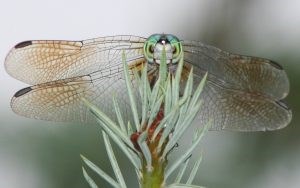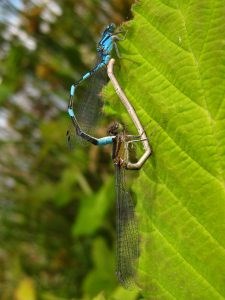This content was originally published by the Longmont Observer and is licensed under a Creative Commons license.
A staple of summer, dragonflies and damselflies abound in Longmont. A relatively new pastime, dragonfly watching, or oding, is becoming more common. Their agile acrobatics as they chase their prey make for interesting watching. The Front Range is home to a surprising number of species: approximately 45 species of dragonflies and 28 species of damselflies. Park yourself anywhere you find water and you are likely to come across a few of them.

The term dragonfly is often used to refer to both dragonflies and damselflies, although they are in fact different. Both belong to the same order of insects, however. There are four characteristics that can be used to differentiate between a dragonfly and a damselfly. These are the eyes, body shape, wing shape, and position of the wings at rest. Dragonflies have very large eyes that wrap around from the side of the head with no gap visible between the eyes. Damselflies on the other hand have a visible gap between their eyes, with their eyes sitting more on the sides of their heads. Dragonfly bodies are larger and stockier than that of a damselfly. The body of a damselfly is more like a twig in appearance. Although both dragonflies and damselflies have two sets of wings, the shape is different. Whereas damselfly wings have the same shape between the two sets, dragonflies have two different shaped wings.

Damselfly wings taper as they join the body. The hind set of wings on dragonflies are larger than the set in front, and they broaden as they reach the body. At rest, dragonflies hold their wings out to the side like an airplane. In contrast, damselflies fold their wings up forming a “v” shape. To make things easier, I’ll refer to both dragonflies and damselflies as dragonflies.
Dragonflies and damselflies begin life as insect larvae hatched from eggs that were laid in water. Eggs may be attached to vegetation over or in the water or could be just dropped in the water. The female may become completely submerged during the egg-laying process. The larvae eat insects, small fish, and tadpoles, and they have voracious appetites. Dragonfly larvae are called nymphs. The majority of the life cycle of a dragonfly is actually spent as a nymph, spending up to five years as a nymph for some species. When the nymphs emerge from the water, the skin splits and the dragonfly emerges. Blood vessels in the wings pump blood which helps the wings to unfurl. Once the wings have unfurled, the blood supply is largely cutoff from the wings forming patterns of empty vessels that can be used to identify the species of dragonfly. Many species of dragonflies mature away from the water, returning only when they become sexually mature. Males tend to be more brightly colored than females. When the males and females mate, they form a “mating wheel.”

Some species of dragonflies have been known to take prey as large as a hummingbird. To capture larger prey, the legs are used to form a basket around prey. Smaller prey is captured with the mouth. The large eyes of dragonflies give them an advantage, with up to 30,000 lenses per eye. This allows dragonflies to pick up single wingbeats of insects that might look like a blur to us. Dragonflies can scan nearly 360 degrees above and below them, and see in color. Eyesight is the most important sense for a dragonfly as they are deaf, can barely smell, and do not vocalize. Dragonflies have strong wings that can be moved independently of each other, allowing them to fly sideways and backwards and hover. Their antennae serve to tell them things like wind speed and direction, further helping them fly. Some species can fly up to 18 miles per hour and one species is capable of migrating across the ocean. Their jaws are serrated and powerful and the success rate of hunting dragonflies is 95%!
If you want to watch dragonflies, there are a few tips to consider. A good pair of binoculars is useful as you may not be able to get close enough on foot to identify the species. A digital camera can also be useful, allowing you to preserve the moment for later study although they can be hard to photograph. That being said, it is possible to get close to dragonflies if you sneak up on them from behind. That is where their blind spot is located. Be slow and deliberate and avoid shaking surrounding vegetation. You can also choose to find a spot and sit still waiting for the dragonflies to come to you. Whichever method you choose, you are sure to find hours of entertainment observing and getting to know the dragonflies in your neighborhood.


